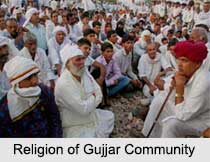 Religion of the Gujjar Communities has two endogamous religious sections and these are Hindu and Muslim. Each section is further subdivided into a number of exogamous gotra like Khatana, Chohan, Gursi, Didhar, Bhumphal, Kalarya, Parswal, Mahehria, Koli, Kautiya, Motte, Chaichi, Bhunch, Bargat, Kalas, Chhore, Ladi, Chai, Bajar and Badhana. These gotra denote its ancestry and also regulate marriage alliances. They are also aware of the varna system and place themselves along with Kshatriyas, though other communities consider them a grade lower.
Religion of the Gujjar Communities has two endogamous religious sections and these are Hindu and Muslim. Each section is further subdivided into a number of exogamous gotra like Khatana, Chohan, Gursi, Didhar, Bhumphal, Kalarya, Parswal, Mahehria, Koli, Kautiya, Motte, Chaichi, Bhunch, Bargat, Kalas, Chhore, Ladi, Chai, Bajar and Badhana. These gotra denote its ancestry and also regulate marriage alliances. They are also aware of the varna system and place themselves along with Kshatriyas, though other communities consider them a grade lower.
History of Gujjar Community
Tradition has it that the Gurjars or the Gujjars are a community with no fixed abode. A large number of Gujjars have now settled down and taken to farming. In some areas, they continue to pursue agricultural activity along with animal husbandry. Traditionally, they were cattle breeders and milkmen. During the Turkish, Afghan and Persian invasions, they earned notoriety for prepping upon the dead and the wounded left in the battlefields.
Hindu Gujjars in India
The Hindu Gujjars are usually vegetarian and their diet depends upon the availability of cereals. They believe in the supremacy of the conventional joint family structure. They are hard working. The major life-cycle rituals commencing with the birth of a child are broadly in accordance with the Hindu customs. Traditionally, the economy of the Hindu Gujjars revolves around buffalo and cow herding and by means of agriculture.
Muslim Gujjars in India
Most of the Muslim Gurjars are non-vegetarian. Marriages in Muslim Gujjars are performed nowadays in adulthood by negotiation. A distinctive feature of their marriage is that consanguineous marriages take place. The family of the Gurjars is mostly of the extended type but at times nuclear families also come up. The inheritance of the property is from father to sons, who equally share it. Women in Muslim Gujjars have right to family rituals. She controls the family expenditure. Muslim Gujjars bury the dead and the mourning lasts for three days.
Majority of both the Hindu and Muslim Gujjars are pastorals and they make out their livelihood through the sale of milk products. They have herds of buffaloes with which they keep on migrating from low to high and high to low attitudes during summer and winter season in search of green pastures.









